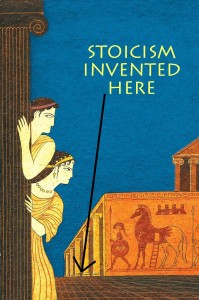 I’ve been studying Stoicism as a practical philosophy fairly intensely for several years now, and up until recently I accepted what has become received wisdom in the modern Stoicism community about the relationship among three important components of Stoic philosophy: the practical disciplines as laid out by Epictetus, the four cardinal virtues, and the three fields of study comprising the classical Stoic curriculum. Such received wisdom comes from the work of Pierre Hadot, as articulated in detail in The Inner Citadel (full pdf here). Hadot develops a correspondence between the disciplines and the fields of study within the context of his discussion of the philosophy of Epictetus (ch. 5), and he also constructs a correspondence between the virtues and the disciplines when he discusses Marcus Aurelius (ch. 9). I have summarized his take in this post, which is accompanied by what I was hoping to be a handy diagram to put the whole thing together.
I’ve been studying Stoicism as a practical philosophy fairly intensely for several years now, and up until recently I accepted what has become received wisdom in the modern Stoicism community about the relationship among three important components of Stoic philosophy: the practical disciplines as laid out by Epictetus, the four cardinal virtues, and the three fields of study comprising the classical Stoic curriculum. Such received wisdom comes from the work of Pierre Hadot, as articulated in detail in The Inner Citadel (full pdf here). Hadot develops a correspondence between the disciplines and the fields of study within the context of his discussion of the philosophy of Epictetus (ch. 5), and he also constructs a correspondence between the virtues and the disciplines when he discusses Marcus Aurelius (ch. 9). I have summarized his take in this post, which is accompanied by what I was hoping to be a handy diagram to put the whole thing together.
Even though something definitely appealed to me in the idea of drawing correspondences among those three aspects of Stoic theory, something also struck me as not quite right. For one thing, there are four virtues, three disciplines, and three fields, which really clashes with my sense of symmetry. More importantly, I noticed that every time I had to explain the whole system to someone, I would have to pause and try to remember, or reconstruct, Hadot’s explanation for it. That is not a good sign, it means that the system does not come natural to me, that there is something that does not feel quite right about it.
During a recent discussion at the New York City Stoics meetup, facilitated by my friend Greg Lopez, we were talking about this with our special guest, Brian Johnson, author of the excellent The Role Ethics of Epictetus: Stoicism in Ordinary Life (my six-part commentary of that book is here). In it, Brian argues that Hadot’s interpretation is forced, and does not quite reflect Epictetus’ own philosophy. At some point during the conversation, it struck me not only that Brian was likely to be right, but that I had also developed a somewhat clear idea of why. I am going to present that idea below, in the hope that it may be useful to others to better understand Stoicism as whole.
First, though, a quick recap of the three components of Stoicism among which we want to figure out the proper relationship: the disciplines of Epictetus, the cardinal virtues, and the classic fields of study.
Epictetus’ three disciplines: these concern desire (of what is and is not appropriate to want), action (regarding our relations to others), and assent (to give to or withdraw from “impressions,” i.e., our initial, automatic judgments about the importance of things).
Here is how Epictetus puts it in the Discourses:
“There are three areas of study in which someone who wants to be virtuous and good must be trained: that which relates to desires and aversions, so that he may neither fail to get what he desires, nor fall into what he wants to avoid; that which relates to our motives to act or not to act, and, in general, appropriate behaviour, so that he may act in an orderly manner and with good reason, rather than carelessly; and thirdly, that which relates to the avoidance of error and hasty judgement, and, in general, whatever relates to assent. Of these, the most important and most urgent is that which is concerned with the passions [i.e., the first one]. … The second is concerned with appropriate action; for I shouldn’t be unfeeling like a statue, but should preserve my natural and acquired relationships. … The third belongs to those who are already making progress, and is concerned with the achievement of constancy in the matters already covered, so that even when we’re asleep, or drunk, or depressed, no untested impression that presents itself may catch us off guard.” (III.2.1-5)
Notice here that Epictetus basically lays out a sequence for his Stoic curriculum: the most important thing, and the first one to study, is how to properly direct our desires and aversions. Which should train ourselves to desire only whatever is under our control, and to treat everything else as not being up to us. Once we muster that, we are ready to properly act within the world. It is important here that Epictetus reminds his students that we don’t want to be “unfeeling like a statue” — so much for the stereotype of the unemotional Stoic. It is, finally, only the advanced student that can tackle the third discipline, that of assent, which allows us to arrive at good judgments.
The four virtues: as is well known, there are four virtues in Stoic philosophy: practical wisdom, courage, justice, and temperance. There are several definitions of them in the Stoic canon, but perhaps the most compact and informative ones are found in Cicero’s De Inventione (On Invention):
“Virtue is a habit of the mind, consistent with nature, and moderation, and reason. … It has then four divisions — prudence, justice, fortitude, and temperance. Prudence [i.e., practical wisdom] is the knowledge of things which are good, or bad, or neither good nor bad. … Justice is a habit of the mind which attributes its proper dignity to everything, preserving a due regard to the general welfare. … Fortitude [i.e., courage] is a deliberate encountering of danger and enduring of labour. … [And] temperance is the form and well-regulated dominion of reason over lust and other improper affections of the mind.” (II.53-54)
Keep these definitions in mind, we will come back to them.
The three fields of study: finally, a quick look at the three fields, in the summary provided by Diogenes Laertius in The Lives and Opinions of the Eminent Philosophers:
“Philosophic doctrine, say the Stoics, falls into three parts: one physical, another ethical, and the third logical. … They liken Philosophy to a fertile field: Logic being the encircling fence, Ethics the crop, Physics the soil or the trees. … No single part, some Stoics declare, is independent of any other part, but all blend together.” (VII.39-40)
Diogenes then goes on explaining in detail the parts of each of the three fields, from which it is clear that: (i) “physics” is the study of how the world works (i.e., our natural science and metaphysics combined); (ii) “logic” is the study of how to reason well (which today would include formal and informal logic as well as psychology, with its understanding of cognitive biases); and (iii) “ethics” is much broader than today’s concern with right and wrong, and it is actually conceived as the study of how to live your life well.
The problem with Hadot’s system: we are now in a position to recap Hadot’s suggested correspondence among the disciplines, the virtues and the fields, after which we will see why Johnson rejects it, and examine my substitute proposal.
Here is my rendition of the Hadotian system in the earlier post linked above:
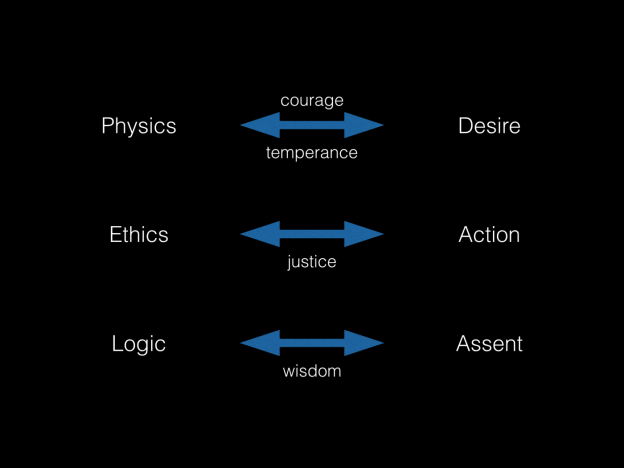
The general idea is that the discipline of desire is related to physics because one needs to understand how the world works in order to figure out what is and is not proper to desire; these two, in turn, are connected to the virtues of courage (to accept the dictates of the cosmos) and temperance (to regulate one’s actions accordingly). The connection between ethics and the discipline of action is the most obvious one, since action regulates how we interact with others; the corresponding virtue is, naturally enough, justice. Finally, assent is linked to the study of logic because perfecting reasoning improves our judgment, and hence allows us to properly examine our impressions; the relevant virtue is practical wisdom, which steers us through morally complex situations.
It’s a neat system (except for the asymmetry, noted above, between the number of virtues and the rest), but it finds little evidential support in Epictetus. Johnson points out that Epictetus usually does not mention the fields, except, interestingly, logic. Regarding the latter, he holds an interesting position: on the one hand, he makes fun of those among his students who are into logic chopping:
“If I admire the interpretation [of a philosophical treatise], I have turned into a literary critic instead of a philosopher, the only difference being that, instead of Homer, I’m interpreting Chrysippus.” (Enchiridion 49)
On the other hand, he also clearly thinks that without logic there simply is not philosophizing at all:
“When one of his audience said, ‘Convince me that logic is useful,’ he said, Would you have me demonstrate it? ‘Yes.’ Well, then, must I not use a demonstrative argument? And, when the other agreed, he said, How then shall you know if I impose upon you? And when the man had no answer, he said, You see how you yourself admit that logic is necessary, if without it you are not even able to learn this much — whether it is necessary or not.” (Discourses II, 25)
I’m going to make a note of this quote for the next time someone asks me what logic (and, by extension, philosophy) has ever done for them…
Johnson has additional worries about Hadot’s system, for instance that the connection between physics and the discipline of desire especially seems to be forced. Interested readers are referred to pp. 79-80 of his book. Indeed, if one reads chapter 5 of The Inner Citadel, it is pretty clear even to the casual observer that he struggles mightily to connect physics and desire. Another worry correctly expressed by Johnson is the fact that Epictetus does not use the virtues in his teachings, deploying instead his rather novel approach of role ethics; on this, see mostly chapter 1 of The Role Ethics of Epictetus, especially the last part of it. As for Marcus, Hadot himself traces the concepts in the Meditations to an amalgam of traditional Stoicism, influences from Epictetus, and even Platonism. Marcus was not a philosopher, and it is hard to construct a system of any sort from what is, after all, his personal diary.
For these reasons, and as a result of my own reading of all the above authors, both modern and ancients, I find myself in agreement with Johnson that Hadot’s quasi-neat system of correspondence among disciplines, fields, and virtues is a bit artificial and strained. What then?
A new way to conceive of the full Stoic system: it occurred to me that there is plenty of evidence that the Stoics thought of each of the three subject matters we have been discussing in a rather unitary, holistic, fashion: they argued, most famously, for the unity of virtues, which I propose to represent as a tetrahedron with four faces (practical wisdom, courage, justice, and temperance), all aspects of a fundamental object, which we can simply call virtue. Here is the visual:
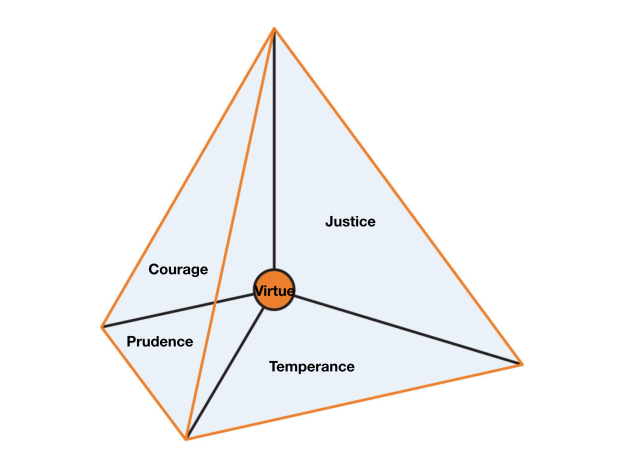
The reasons the virtues are deeply interconnected is because it makes little sense to try to use them separately. Consider: courage is not just physical bravery, but rather the moral courage to stand up for what is right. But how does one know what is right? That falls under the domain of the virtue of justice. Then again, as Cicero clearly says above, practical wisdom (prudence) is the virtue that tells you what is good, what is bad, and what is neither, surely pertinent knowledge to exercise justice. And it takes all three to practice temperance about one’s own passions, because one has to know the difference between good and bad, have the courage to act on it, and do so with the general welfare in mind. You simply can’t have one without the others.
The three fields of study, while formally distinct, were also deeply interrelated. The Stoics very clearly did not study physics and logic for their own sake (see my discussion of curiositas vs studiositas). Here, for instance, is Seneca to his friend Lucilius on the subject:
“How many superfluous and useless things are to be found in the philosophers. Even they have descended to the level of drawing distinctions between the uses of different syllables and discussing the properties of prepositions and conjunctions … with the result that they are more diligent in speaking than in living. Listen and let me show you the evils too much subtlety can create, and what an enemy it is to truth. Protagoras says that in all things it is possible to argue both sides of any question with equal force, even the question whether or not one can really argue either side of a question! Nausiphanes says that of the things that seem to us to exist, none exists anymore than it does not exist. Parmenides says that, of all the phenomena, none exists except the whole. Zeno of Elea has dismissed all such confusions by introducing another confusion: He declares that nothing exists … All these theories you should throw on that heap of superfluous liberal studies.” (LXXXIX.42-45)
The above description, unfortunately, can still be applied, almost two millennia later, to much of what goes on in modern academic philosophy departments, but that’s another story…
Their holistic thinking is why the Stoics came up with a number of metaphors to make clear the interconnectedness of the three fields, the best of which is, in my opinion, that of the garden as presented by Diogenes Laertius. Logic is necessary to keep out the weeds of bad reasoning; physics nurtures our understanding of reality; and ethics applies both reasoning and understanding to the crucial task of living well.
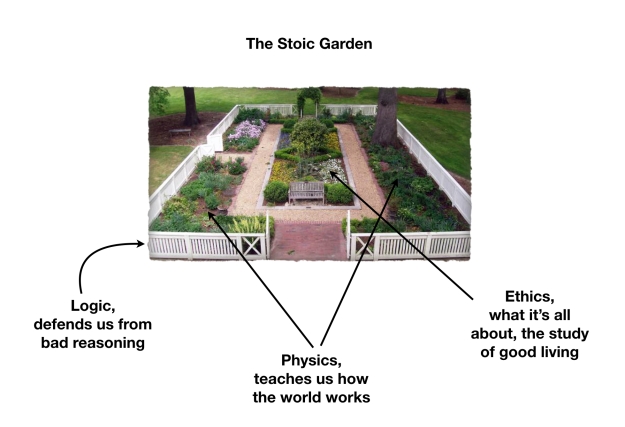
What about the three disciplines, then? They too are conceptually distinct and yet obviously tightly interconnected, as it is clear from Epictetus’ treatment of them and the explicit sequence he lays out in the Discourses, mentioned above. This is a diagram to grasp the basic idea:
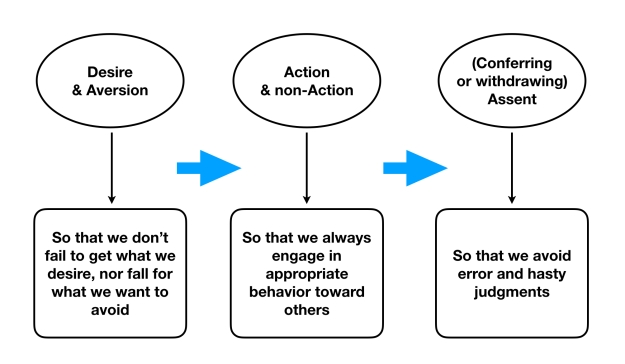
If my analysis (built on Johnson’s critique of Hadot) is correct, then a better way to look at the relationship among the disciplines, the virtues, and the fields of study is an integrated one, reflecting the recurrent Stoic way of treating things as conceptually distinct and yet practically deeply connected. Here, then, is my attempt at how we should see the full shebang:
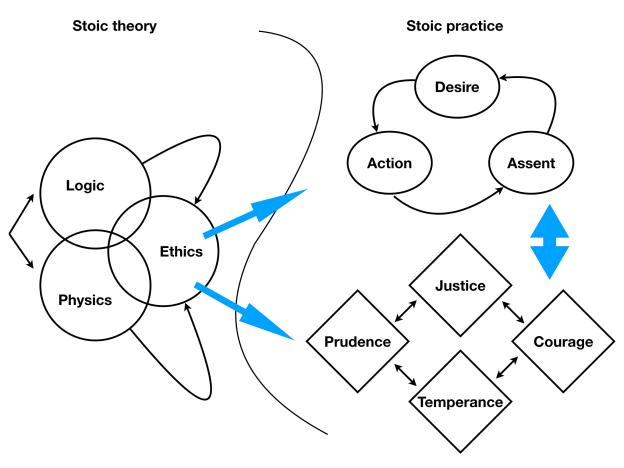
Briefly, on the left we have Stoic theory, comprising of course the fields of study of logic and physics (which inform each other), but also ethics (which is informed by the other two). On the right side is Stoic practice, which can be conceptualized either in terms of the virtues (lower part of the diagram), as in classical Stoicism, or in terms of the disciplines (upper part of the diagram), as emphasized by Epictetus. The virtues reinforce themselves, but could also be understood as reference points that make it possible to actually practice the disciplines (though, alternatively, one could follow Epictetus’ original alternative based on his theory of roles). Conversely, the disciplines are what makes the virtues useful in real life, giving them substance, so to speak. Finally, notice that the three areas of study inform both the articulation of the disciplines and the nature of the virtues.
There are two main reasons so many people have been attracted to the system of Stoic philosophy over the past 23 centuries: it is eminently practical, and it has a beautiful internal coherence. The diagram above should make clear why.
_____
Important note on terminology: throughout this essay I have avoided the word “topoi” (sing., topos) because it has been used confusingly in the public literature, including, unfortunately, by myself. Sometimes people use it to refer to the disciplines (desire, action, and assent) and sometimes to the fields of study (logic, physics, and ethics). Johnson, for instance, uses “topoi” in reference to the disciplines, while Robertson, in his Stoicism and the art of Happiness, applies the word to the fields of study. I checked Hadot’s treatment of the matter in The Inner Citadel, and it turns out there is a good reason for the confusion: it originated with Epictetus himself! Hadot writes: “In order to designate these exercises [the three disciplines], Epictetus uses the word topos, a term traditionally used by the Stoics — at least since the time of Apollodoros of Seleucia — who flourished at the end of the second century BCE — to designate the parts of philosophy [the three fields].” So it appears that part of the basis for Hadot’s suggestion of a correspondence between disciplines and fields is the fact that Epictetus used for the former the word traditionally employed for the latter. At any rate, to avoid any further confusion, I adhered to the English words “disciplines” and “fields (of study).”

Massimo, thank you for your succinct and lucid summary of Stoic Philosophy. I really like the tetrahedron diagram in how the four virtues support each other and contain within them an essence of virtue. The discipline and clarity of the garden and other diagrams are very helpful. I will certainly be forwarding this one on to anyone who has shown curiosity on the subject.
LikeLike
That virtue pyramid though… I’m seeing a great laser-engraved paperweight possibility!
LikeLike
This is a helpful article. I must admit that I struggled with Hadot’s connection of physics to desire and aversion. I’m not a scholar of Epictetus, but it feels to me as though the four virtues would perfectly match the three disciplines if we consider desire and aversion as distinct passions, with unhealthy desires requiring temperance and unhealthy aversions requiring courage. Conversely, we might consider that courage and temperance involve the same underlying process of judging passions correctly, so maybe Epictetus’s disciplines are a cleaner representation than the Hellenistic virtues that the Stoics inherited. Perhaps we should consider whether the disciplines and the virtues are redundant.
LikeLiked by 1 person
Sean,
More than redundant, I think of the virtues and the disciplines as two different ways to explain and practice Stoic philosophy.
LikeLiked by 1 person
Just a bit of wondering: logic (broadly understood) and physics are the basis of much or most of modern science and technology. Ethics seems to be the illegitimate cousin. But doesn’t the study of human evolution, the incredible knowledge we are gaining about human cognition, as well as understanding how humans behave in a group stand as firmly grounded as logic and physics?
This newer knowledge of our specie provides a value free look at who and what we are, just as logic and physics are themselves value free. Hence the three are parallel studies. There are advantages to looking at human ethics as in itself value free. Mainly it provides a firmer grounding of what we can and should expect from ourselves and our neighbors.
The recent advances in protecting women and children from sexual harassment and abuse from an evolutionary and social point of view is a good example. Powerful men have always and everywhere exercised that power and abuse over less powerful women, children, and of course less powerful men – in all cultures and societies (tribes had some interesting exceptions). And those less powerful, especially men, in turn used and abused those even less powerful. Secrecy, social convention, assigned shame to the abused not to the abuser – adding a strong note of approval to the powerful and disapproval to the abused. This strikes most as horrific. But astoundingly it was only in the 1970s that human society addressed this.
A less emotionally charged study was that of car accidents, for most of my younger years it was always considered the driver’s fault. Drivers just need to be more careful, drive slower, pay more attention, follow the law better. ( all good things in themselves, but considering ethics useless is reducing accidents). Starting in about the 60s that changed. Perhaps it was as much the cars and roads that were as much at fault. Cars changed, roadways changed, and the deaths per 100 million miles dropped.
LikeLike
Massimo,
As always I greatly appreciate your thoughtfulness and dedication. Though I am a mere prokoptpon I disagree that ‘virtues and the disciplines as two different ways to explain and practice Stoic philosophy.”
Consider the thought experiment of an archer who finds herself in a position that they can help their starving brother if only they win the archery tournament to be held in 2 weeks. Consider 2 scenarios. In one the archer understands the 3 Discipline but she is not otherwise wise, a coward, and selfish. In the other scenario the archer has all 4 virtues but does not follow the 3 disciplines. This could take us to a long discourse – but you end up with 2 very different people , 2 different lives – neither approximating eudomonia. It seems the disciplines and virtues are 2 separate ( though related) entities that are integral to Stoicism.
LikeLike
Woolsey,
Thanks for the kind words. My response to your hypothetical scenario is that someone who understands but does not practice the disciplines (or the virtues) is simply not behaving like a Stoic. There is a reason, according to Johnson, why Epictetus does not use the virtues almost at all in the Discourses: because he replaces them with the three disciplines and his theory of roles. The result, seems to me, is the same, hence my contention that those are two complementary way to see Stoic philosophy.
LikeLike
Helpful, thanks.
LikeLike